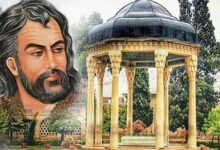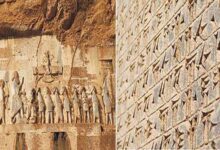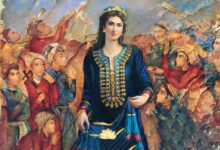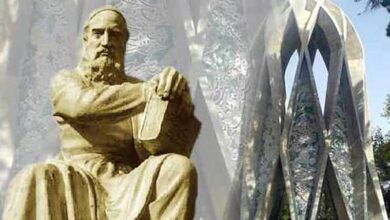Take a Look at Rostam and Shahnameh

In this article, we first examine Rostam’s character and his place in Iranian mythological thought, and especially his role in “Shahnameh”. Meanwhile, the background of Sam, Nariman and Rostam Dastan families (as Hakim Ferdowsi shows us) is examined.
Also, from the point of view of morphology (facial recognition, etc.) and in the tools and equipment of Pahlavan Rostam and his only helper, Rakhsh, there is a discussion.
Another point is the good qualities of Rostam that are specially gathered in him. Such as: strength, artistry, belief (trust), resourcefulness, interest in battle, language, loyalty, chivalry and heroism that is clearly manifested.
Also in Haft Khan, it is a symbol of Rostam’s excellence. And Rostam is the embodiment of the perfect Iranian man who has encounters and challenges with mythical creatures such as dragons and demons.
Shahnameh, as the history of Iranian painting has shown, is the most pictorial and well-paid literary narrative that has a significant and exemplary place in the way of expressing space, pages, human and even animal figures, colors and descriptions of mythical creatures.
Both the narrations of Ferdowsi and the pictorial payments of Iranian painters during this millennium (almost most of the famous painters of Iran); One of the golden leaves of their life was the illustration of Ferdowsi’s Shahnameh.
Shahnameh is our historical book, Iranians. Perhaps in no historical period of Iran has a book been more illustrated than the Shahnameh. And almost more than any other book considered by kings except Sultan Mahmud of Ghazni who did not appreciate the sage; have been. As well as biased people who do not get along well with Iranian culture. The painters paid special attention to this book because Froudesi’s book is more visual than any other book. And this lies in both Ferdowsi’s expression and its mythological narratives. Hence, Shahnameh is both the source of Iranian illustration and the source of research. But it has never been noticed in its visual position (nor imagery).
Despite its mythical look, Shahnameh is quite tangible and its only point is Ferdowsi’s pictorial expression. The reader of Ferdowsi’s poetry feels completely close to its characters. The moods of the characters, the change in the shape of the faces (what is common among playwrights, that is, facial mimicry), the atmosphere of feasting or fighting, flirting or arguing, and even the bright face in Ferdowsi’s poetry are fully depicted for the reader.
Rostam is the symbol of the Iranian man. He is a hero who undergoes mental transformation in various tests. He is the first reader of “sleep” and thanks to God and Rakhsh’s efforts, he survives in good health. He sometimes disobeys like any other human being. Sometimes he forgets his promises and, of course, because he is a myth and fights with mythical creatures; Fewer negative points of the identity of the reader are identified. And this is what the reader wants and Ferdowsi was very aware of it. Persian myths in many cases originate from the Shahnameh of Froudesi. And in no other book has human thought entered the transcendental boundaries of the Iranian imaginary world.
Everything that tests the Iranian hero and even his enemy, is collected in the highest and most dangerous form possible in this weighty book. Turan and Turanians have always been a symbol of the enemy and aggressor for this border and region. And Ferdowsi has in fact revealed what existed in the mental subconscious of the Iranian singer. Hence, it is a sign of Iranian culture for both Iranian and non-Iranian communities. And perhaps the reason why the Persian kings waited for years to illustrate a copy of the Shahnameh and after a while presented it to other countries, was because they considered it a factor and symbol of Iranian power and culture that was tangible to others
Rostam’s life and family
Rostam, Jahan Pahlavan, slanderer of Pilten, who is the first hero of Shahnameh. The history of Sistan says from the words of Ferdowsi “.. God Almighty did not create any servant like Rustam …. He believes that nothing like him has been found in the Iranian national epic. Every heroic epic has all the ideals and aspirations of a people embodied in him, like Achilles in the Iliad of Hamrorama, in the Indian Ramayans. Rostam also revolves the entire heroic period of Shahnameh around his existence. The strange thing is that this man, whose life is mixed with all the myths, his existence will never be separated from an ordinary earthly human being. He is a man with flesh and blood and bones, with human weaknesses and abilities, he does not even have a body. However, his physical and mental strength overcomes the events. God’s luck and approval are with him. Even when the demon takes him off the ground and puts him on the verge of extinction. He survives by trickery, and it is not unusual for someone to fall from the sky into the sea and survive. The wonder of Rostam’s existence is that while he is extraordinary, he is a human being. If we pass through his incredible longevity in a few incidents such as Haft Khan, we see almost no income in his life that we can not justify with our earthly logic.
Rostam, son of Zal, son of Sam, son of Nariman, is from the Garshasb family and his mother, Rudabeh, is the daughter of Mehrab Shah Kaboli. The Garshasb family was one of the most important Iranian families, and its men, who were the first heroes after each other, were known for both arm strength and wisdom. Their domain was Sistan. Rostam, as described in the Shahnameh, represents a complete hero in fictional Iran. This man is the embodiment of the thoughts and aspirations of our predecessors. Man’s urge and effort for a better life, for the path to the exaltation of victory and destruction and ugliness. He finds his best manifestation in epic heroes, and Rostam, among these epic heroes, must have all the necessary qualities in him. Only death can not overcome it. Death is the end of the journey. In the lives of heroes, death is the pinnacle of life. It is death, which gives life, awe and grandeur and meaning, the meaning of every hero’s life in the way he dies.
Childhood and Adolescence
Because Rostam has chosen a man, the way he is born is different from the birth of others. Rudabeh, a woman with hallucinations, feels from the time of pregnancy that she has a child in her womb other than normal children. Because the child cannot get out of the mother’s womb due to its large size, Zal seeks help from Simorgh. The “ruler chicken” comes and orders that Rudabeh be intoxicated with intoxicating extract, and that his side be cut open, and that the child be taken out of his side.
Simorgh predicts the following about the child:
From this cypress, one lion is on the skill of a lion, you do not want the soil to fall on him, he does not care, his head is turned upside down, and his song becomes a leopard war leather.
Sometimes Sam’s wisdom was a war of rage inside the forest lion
Another characteristic of Rostam is that it is the fruit of love, the love of Zal and Rudabeh, who have connected the two races of Iranians and greyhounds (Mehrab, the father of Rudabeh, is the grandson of Zahak).
This connection takes place between two families who have been enemies for a long time.
When a child is born, they give him the name “Rostam” and make a statue of silk stuffed with sable hair from his body and send it to his grandfather Sam. This statue shows the childlike awe of Rostam. :
One of the children was sewn from silk on top of that uneaten milk. The milk inside the ottoman’s hair owl is holding Nahid and Hoor has two arms on the brave dragon and the fork of the lioness has embraced Sinan with one hand Copal and the other Annan
Rostam is such that his two midwives have to breastfeed him, and since he is weaned, he gets five men to eat.
Chou Rostam was free to walk on eight sabans. One of them became free. It became so that Rakhshan became a star. The world was observed as a star.
And because Sam comes to see him at this age, he is surprised to see him:
Give him a vial arm of that height and horn, such as a pen, and a wide Weber chest
In his time, Churan Hyunan was a big lion and the force of Hezbar’s followers
And Rostam has been asking for weapons from the world since he was eight years old.
One of my servants ate the hero Sam and fell asleep
I will ask for a heavy horse and I will send it to you
Rostam’s first heroic act, when he is still a child, begins with killing the white elephant. The great elephant of Zal is released from prison and because he is afraid that he will destroy others and no one can be equal to him, گر Rustam takes the wand of Sam’s prayer and knocks on his head and kicks him. His second heroic act is to go to “Sepand Mountain”, to the mountain of a huge castle whose people rebelled and until one day it did not succeed in opening it, Nariman was killed at its foot, Sam who marched at the request of his father, after years Besieged, failed to return. After Rostam plays the role of killing the white elephant, his father’s appoints him to conquer the Sepand mountain, and he will open the prayer for Nariman. This is how he describes the castle to him.
Rustam’s stories
Simorgh’s Javanese power will be called for help soon: When a child is born, Zal, desperate to free Rudabeh from the unbearable pains of childbirth, burns Simorgh feathers. He gives the good news to Zal [1] that he will soon have a son who will be the power of an elephant on top of one head ”and this child will be born not in the usual way but by splitting the side. The mother regains her complete health by using the potions prescribed by Simorgh and rubbing the legendary bird on the wound.
The face and character of a hero
The first time Sam visits Rustam, who is no more than eight years old, he sees a young man “ between a pen, chest and snow” and “ his time was Choran Hyunan Stabr” Afrasiab, in the first war, because Rustam’s hand is released, he describes him to his father Peshang as follows:
A ride arose from behind Sam, whose hands are named after Rustam
Be like the whale of the enemy that you said would burn the world to the tail
You said that they made it out of iron and turned it into stone.
Rostam has been described by different people, sometimes ugly and sometimes beautiful.
How is Rustam a man?
We said that in the ancient civilization of Iran, Rostam is a perfect hero. While not free from human weaknesses, he has all the qualities of an ideal man. He enjoys all the blessings of life for a long time. It relies on both its physical strength and its spiritual strength. He lives both high and prosperous, and as far as an earthly human being can dominate the mighty nature, he becomes, at the same time, because he is human. اوHis destiny is not separate from the destiny of human beings, that is, free from some failures.
Rostam Wars
Seven Readers
The most amazing story of Rostam’s life is his seven readers in Mazandaran. Because Kavous is caught in Mazandaran, Zal sends Rostam to rescue him and tells him that there are two ways to get there, one is a long and safe way and the other is a short and dangerous way. Rustam takes the second way, and leaves alone, he says: I do not want to be arrested except by the judge.
* Sources and references are available in the editorial office of Artmag.











